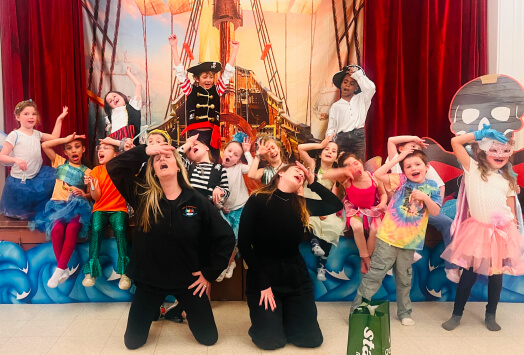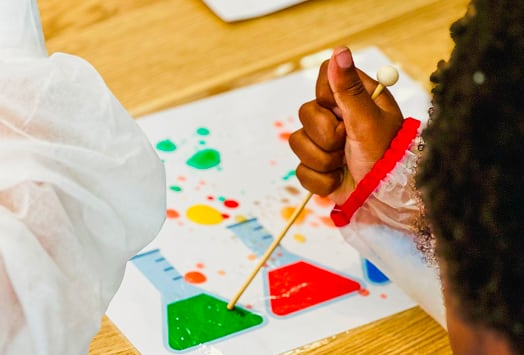In our 2022 Children’s Activity Business Trend Report, we discovered that cheerleading was a trending search term for parents across the country. Therefore, if you are interested in starting a business teaching cheerleading to children, you will be in luck because the demand is there!
At Sawyer, our goal is to help children’s activity providers with all of the business elements so that they can spend more time doing what they love. In this guide, we’ve outlined tips and cheer motions to teach cheerleading to kids and included a downloadable cheerleading lesson plan template that you can adapt for your own classes.

Beginner basic cheer motions
When you start teaching cheer to kids, whatever their ages, it’s important to create a foundation and then build from there. Cheerleading, like any other sport, requires a lot of muscle memory. The only way to build muscle memory is by doing the same motions and activities over and over again. Here are some beginner basic cheer motions to help you get started with your first students.
- Cheer fist. The absolute most basic cheer motion is making a perfect fist. A cheerleading fist should have the fingers tucked in tightly and the thumb wrapped around the fist. A cheer fist usually has the thumb facing out, but some moves might require the pinky to face out instead.
- Clasp. Clasping is like clapping, but the cheerleader cups their hands instead of holding them out straight. Cheerleaders use clasps to make noise. Once they have made the noise, they typically stand with their hands clasped just below their chin and elbows tucked or continue clasping to the beat of the cheer or music.
- Clap. Cheerleaders also clap, but it is more often for stylistic purposes rather than to be loud. A cheer clap looks just like the clasp but the hands are flat against each other.
- Hands on the hips. Cheerleaders often put their hands on their hips in the ready position, between moves, and as part of their motions. When cheerleaders put their hands on their hips, they should be doing a cheer fist right on top of their hip bones. Wrists should be straight.
- Arms down (clean). When cheerleaders put their arms straight down, it’s called a clean. It is often used before moving into a new cheer or motion. Arms should be squeezed tightly on their sides and their feet should be together. Their hands should be straight along their legs (not in fists).
- High and low Vs. A high V is when a cheerleader extends their arms above their head in the shape of a V and a low V is when they extend their arms down in the shape of a V. In both cases, their arms should be at a 45 degree angle and their hands should be in a cheer fist. In addition, their arms should be slightly in front of their bodies.
- Punch. When cheerleaders punch, they have both hands in fists. One hand goes straight up into the air and the other rests at their hip. The raised arm should be close to their ear. Depending on the arm that is raised, it will be either a left punch or a right punch.
- T. A T has both arms extended out so the cheerleader looks like a capital T. Their hands should be in cheer fists and their arms should be slightly in front of their bodies.
- Touchdown. Like the referee, the touchdown motion for cheerleaders requires them to raise both arms straight in the air. They should have cheer fists and the arms should be close to their ears without shrugging their shoulders too much.
- Buckets. In the buckets motion, the cheerleader has both arms punched out in front of them with cheer fists that are facing downwards (like they are holding buckets).

Cheer games
Once you have taught some of the above basic cheer motions to your students, you can start to incorporate games and other fun activities so they can practice and enhance their muscle memory. Games can also help your students learn to trust each other and communicate better, which is important for a cheerleading squad.
Try these cheerleading games during your lessons and watch your students have fun and learn at the same time!
- Simon says. This is a great game to play with your students once you have taught them some of the basic motions and moves. They get the opportunity to practice what they have learned while still having fun. Just make sure you look at their technique and make corrections where needed.
- Blind trust. Pair your students up (preferably with another student they do not know that well). Blindfold one of them and have the other help them navigate around the space. You can even set up an obstacle course for them to go through. This game is all about communication and trust.
- All aboard. This is a fun problem solving game that will help your students become more collaborative and creative. Spread out a sheet and ask everyone to stand on it. Then, have them step off and fold the sheet in half. Ask them to stand on it again. Keep folding the sheet in half after each round and watch your squad work together to come up with creative solutions to keep everyone aboard.
- Emotions. If you are at a place with your students or squad where you have a routine, you can run through your moves and yell out different emotions for them to put on their face as they practice. This can keep them interested and having fun while going through each of their motions. Plus, it helps them remember to keep the right face on when performing.
- Cheer Jenga. Write motions and moves on Jenga blocks and then have your students play. Once they pull a block, they have to do the motion/move that is written on the block. This is a fun way to get them to practice their moves and develop that muscle memory.
Cheerleading lesson plans and template
You might think that teaching cheerleading requires less organization than teaching STEM, for example, because it is more active. But, that is not the case! Any time you teach a class, you should write a lesson plan so that you stay on track with time and content.
When you are teaching cheerleading to kids, we recommend using scaffolding in your lessons. Scaffolding is defined as “a variety of instructional techniques used to move students progressively toward stronger understanding and, ultimately, greater independence in the learning process” by the Glossary of Education Reform. With cheerleading, scaffolding can be offering constructive feedback and suggestions after the routine or exercise finishes.
Use our editable cheerleading lesson plan template to help you stay organized during your classes!
Get our editable cheerleading lesson plan template
We hope that this guide has provided inspiration for your cheerleading classes and lesson plans. If you are a children’s activity provider and you are looking for guidance on managing and running your business, the team at Sawyer is here to help.
With our suite of tools, like custom forms to record allergies and t-shirt sizes, flexible payment options like gift cards and installment plans, and seamless scheduling and registration on any device, Sawyer saves business owners 28 hours per month. If you are ready to spend less time on admin and more time doing more of what you love, see how Sawyer can help with a free trial or demo.





















.png)












.avif)
.avif)
.avif)
.avif)




